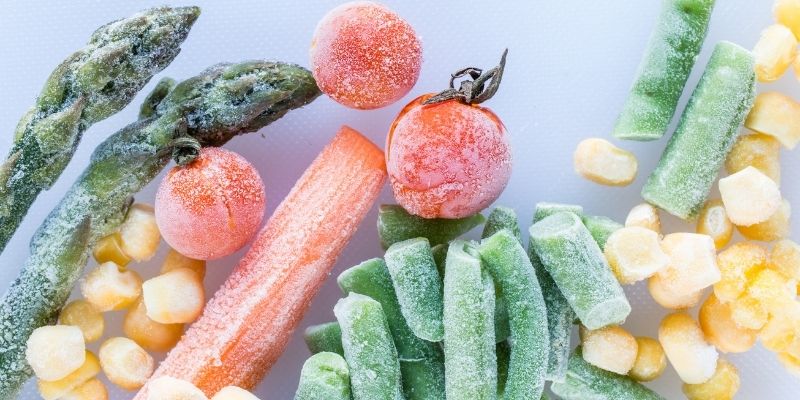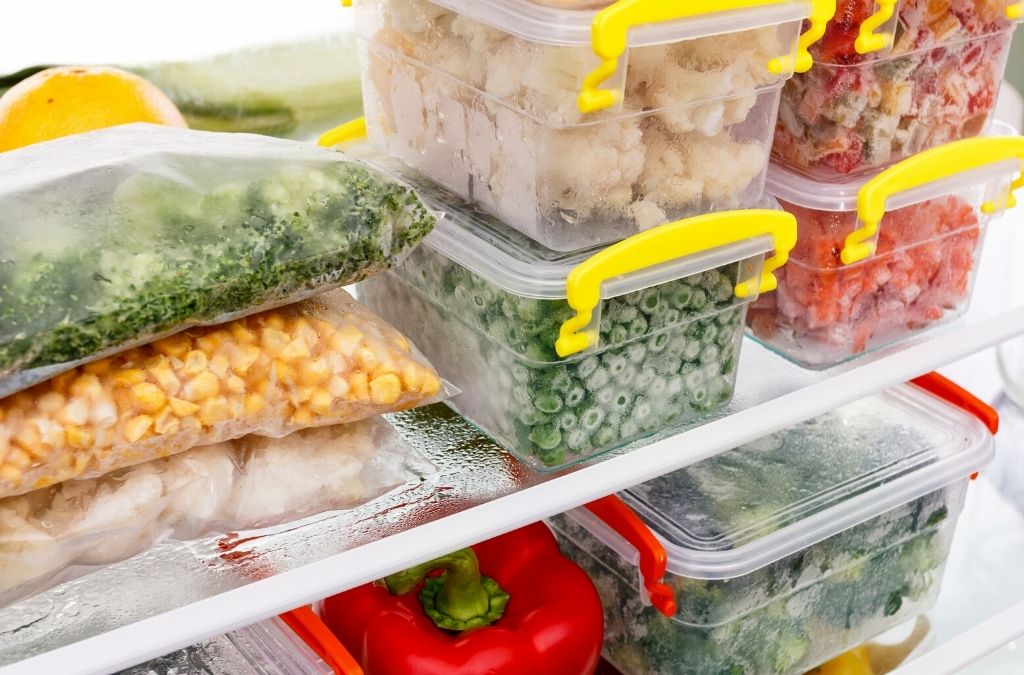To safely store vegetables for long periods of time, freezing them is the best option. Freezing vegetables locks in the flavor and nutrients, and allows you to have fresh vegetables all year round. In this blog post, we will discuss what vegetables can be frozen and how to pack them for long-term storage.
Quick Content Navigation
Why Look At Freezing Vegetables?
It is the process of packing them in an airtight container and storing them at a temperature below 32 degrees Fahrenheit. This method is ideal for long-term storage.
Freezing works on almost all vegetables, including soft-skinned ones like tomatoes and peas.
There are many benefits to freezing your own vegetables, versus buying pre-frozen vegetables at the store. Not only do you preserve their nutrients and flavor, but you control any additives which may include preservatives and colors. Using this method to store vegetables will reduce waste and can save you a ton of money – especially if you grow your own!.
Preparing your vegetables for freezing at home may take a little time, but it is well worth it to have healthy vegetables on hand all year round!
The Benefits of Freezing Vegetables
There are many benefits to it, including but not limited to:
- Make sure your vegetables are fresh and retain their nutrients. Freezing takes a little bit of time in preparation but it’s well worth it in the end! Freezing your vegetables at home also locks in flavors and ensures you can enjoy them all year round.
- Save money. Freezing your own vegetables eliminates the chance of them going bad and being thrown away! You can preserve food for longer periods of time which means fewer trips to the grocery store (and less money spent).
- Reduce waste. By not buying frozen vegetables you will reduce soft plastic use. When freezing your vegetables at home, you can choose reusable containers and further minimize rubbish to landfills.

- Have fresh vegetables all year round. If you live in a part of the country where certain vegetables are only available in particular seasons, freezing gives access to them all year. This is especially helpful if you have certain dietary needs or if you like certain vegetables in your diet.
- Save time. Freezing vegetables that have been processed is an easy way to have them ready for cooking. Frozen vegetables that have been prepared can be used in a variety of dishes, including soups, stews, and casseroles. Chopping them up or even blending vegetables before freezing makes it easy for when you are ready to cook!
What Vegetables Can You Freeze; And What Not to Freeze?
Almost all vegetables can be frozen, but there are a few exceptions.
Avoid vegetables that are high in water content, like lettuce, cucumbers, and unprocessed tomatoes. These vegetables will turn to mush when they are thawed. Other than those few exceptions, almost any vegetable can be frozen!
Do not freeze vegetables if they are:
- wilted, diseased or insect-infested
- overripe
- have been previously frozen (they will not taste as good)
Methods Of Freezing Vegetables
There are two different methods.
- Use the blanching method to prepare your vegetables before freezing
- Freezing them without blanching.
To freeze your vegetables without blanching, you will need a freezer bag or an airtight container like a Mason jar with a lid on it. Freezer bags are easiest because they are more durable than plastic wrap or containers made from other materials such as cardboard. Freezer bags also provide an airtight seal which helps to preserve the color, flavor, and nutrients of your vegetables!
Freezing them using the blanching method is a little bit more time-consuming but it will help retain more flavor, especially if they are going to be used in cooked dishes.
For the maximum life, use a home vacuum sealer and proper vacuum sealer bags. Vacuum sealing your fresh vegetables before freezing them can double or even triple the time they can be safely stored in the freezer.
The above two methods for freezing vegetables can be done through the following steps.
Steps in Freezing without Blanching
- Wash the vegetables and dry them off with a paper towel.
- Cut the vegetables into bite-sized pieces.
- Place the vegetables in a freezer bag. Make sure to remove all of the air from the bag before sealing it shut.
- Label the bag with the date and type of vegetable.
- Place the bag in the freezer.
Steps in Freezing Vegetables using the Blanching Method
- Wash the vegetables and dry them off with a paper towel.
- Cut the vegetables into bite-sized pieces.
- Bring a pot of water to a boil.
- Add the vegetables to the boiling water.
- Cook the vegetables for two minutes.
- Remove the vegetables from the boiling water and place them in a bowl of ice water.
- After the vegetables have cooled down, remove them from the ice bath and allow them to dry. Place them in a freezer bag and remove all of the air from the bag before sealing it shut.
Tips To Pack Frozen Vegetables For Long-Term Storage?
Freezing vegetables is a great way to store them for long periods of time, but it’s important to pack them correctly to avoid freezer burn.
When packing vegetables for the freezer, make sure there is as little air as possible in the bag or container. Freezer burn will occur when oxygen seeps into the packaging and dries out the frozen food. This can cause discoloration, loss of flavor, and an overall deterioration in the quality of your food.
For best results, use freezer bags or containers that are made specifically for freezing. These will have thicker walls and less air leakage than regular storage bags or containers.
- If using regular storage bags or containers, be sure to squeeze all the air out before sealing them up as tightly as possible. Freezer bags are better than regular storage bags because they have a double zipper seal that makes it easier to remove all of the air inside (and help prevent freezer burn).
- Using a vacuum sealer is the best method available. It will prevent freezer burn as all the air is removed, and keep their flavor for longer periods of time.
- If freezing a large batch of vegetables, it’s best to spread them out in one or two layers on baking sheets before putting them into the freezer. This will keep them from sticking together and becoming one big block of frozen veggies. Once they are properly frozen, simply package them in airtight bags or containers. For best results, use a home food vacuum sealer with dedicated vacuum sealer bags.
- Freezing locks in flavors, and blanching first, prevents them from going mushy when thawed out.
Follow these tips when freezing vegetables so they last longer, don’t get freezer burn and you can enjoy your favorite veggies all year!
Listed below are the three highly recommended tools you can use for the best result. Check them out.
Frequently Asked Questions
Q: Why do my frozen vegetables have freezer burn?
A: Freezer burn will occur when oxygen seeps into the packaging and dries out the frozen food. This causes discoloration, a loss of flavor, and an overall deterioration in the quality of the food.
For best results, use freezer bags or containers that are made specifically for freezing, that is double zipper bags. These will have thicker walls and less air leakage than regular storage bags or containers.
To double or triple your safe storage time when freezing vegetables, prepare them as suggested above and use a home food vacuum sealer. This will ensure there is no air in the bag.
Q: Can you freeze fresh tomatoes?
A: Yes, you can freeze fresh tomatoes. They will become soft and mushy when thawed out, so it is best to use them in cooked dishes like soups or sauces. Freezing tomatoes also causes them to lose some of their nutritional value.
Q: Can you freeze onions?
A: You can freeze onions, but they will not retain the same texture or flavor when thawed. Freezing onions may cause them to discolor and lose some of their nutritional value. It is best to use fresh onions for frying but frozen onions are great for soups and casseroles.
Q: Can you vacuum seal vegetables before freezing?
A: Yes, you can vacuum seal vegetables before freezing them. This will help prevent freezer burn and keep the food fresh for longer periods of time. Freezing vacuum-sealed vegetables also takes up less space in the freezer.

Conclusion
Have fresh, out-of-season produce all year round, save money and time by this method of preserving your vegetables. Even reduce waste by using all your fresh produce and sending less plastic to landfills.
So, if you are looking for a way to preserve your vegetables and have them on hand when you need them, freezing is the best option. Not only is it an easy process, but it also allows you to keep your food fresh for months at a time.
Have you tried freezing vegetables on your own? What tips would you add?
So, if you have learned how to freeze vegetables, that is easy as freezing meat.
If you find this article helpful, check out our post wherein we have discussed the best way to save leftovers.
If you are interested in fermentation, we have recently posted a review of the best home fermentation kits and equipment.





 Hi! I’m Sally-Anne!
Hi! I’m Sally-Anne!